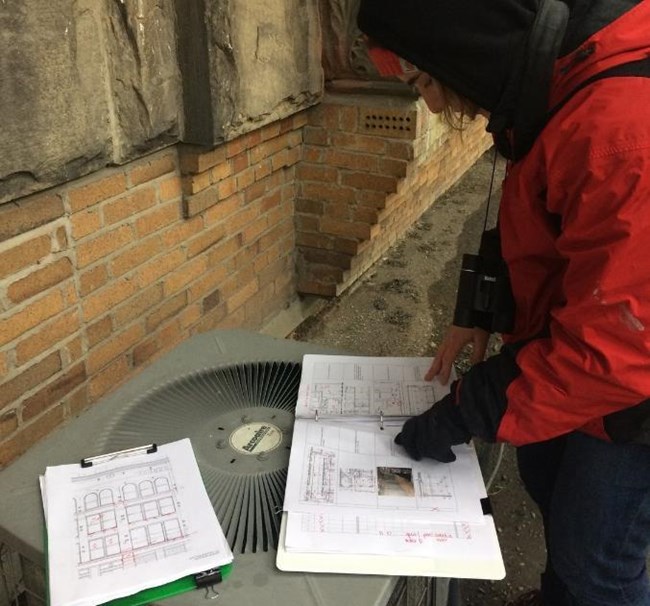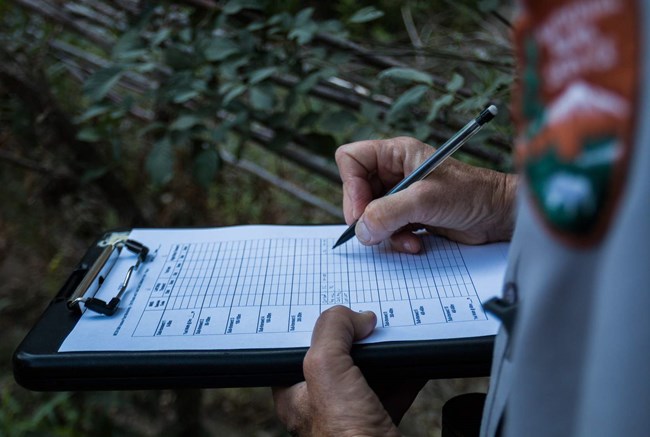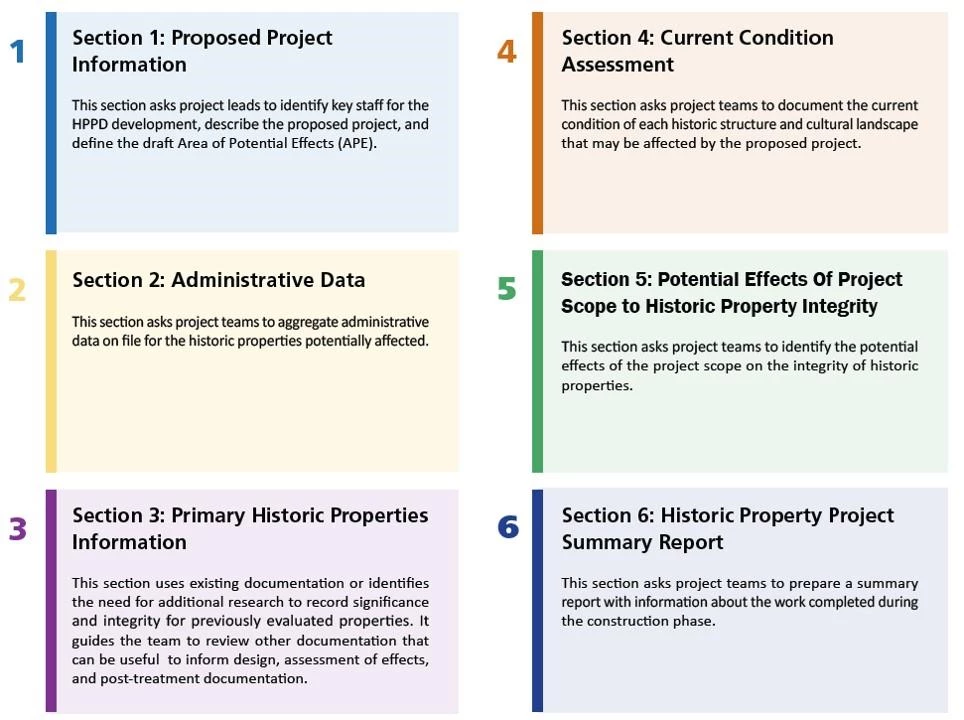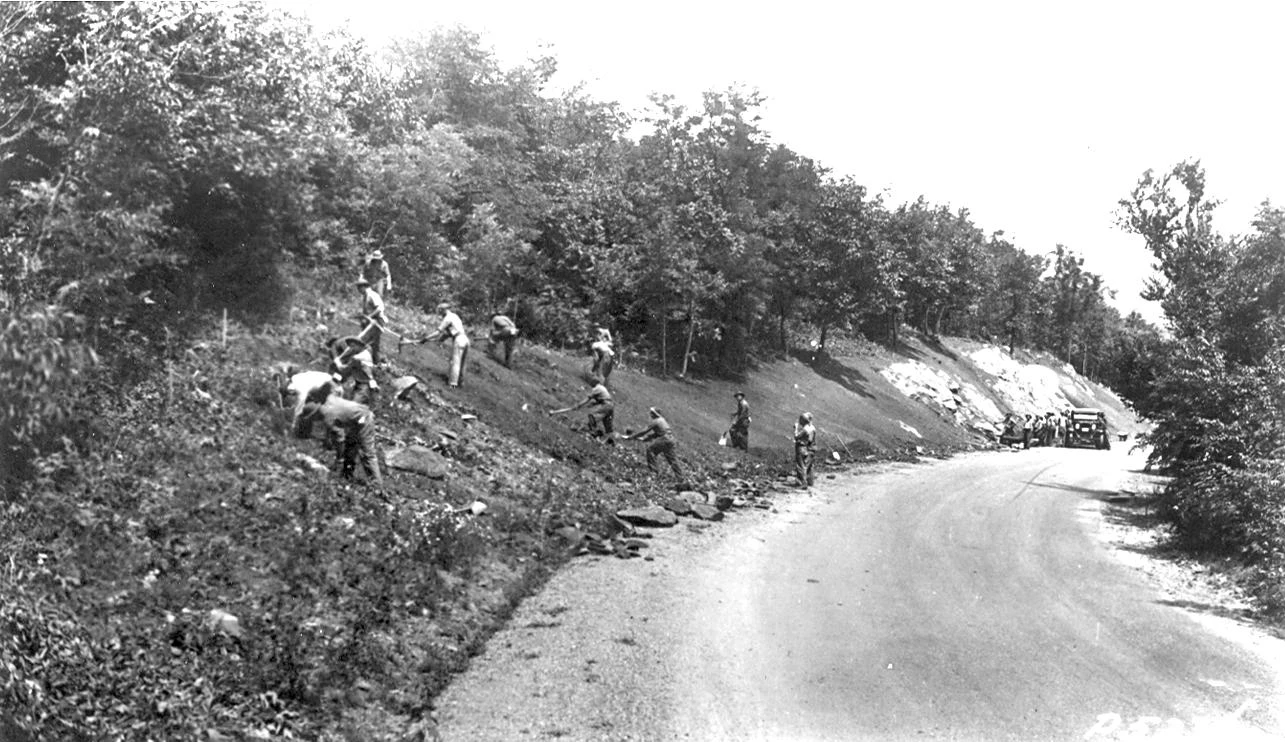Last updated: December 5, 2024
Article
Historic Property Project Documentation Overview

NPS
What is the goal of documenting historic structures or cultural landscapes prior to treatment?
Is there only one way, or a best way to get there?
Why do these questions matter?
The National Park Service has a mission to protect and preserve the nation's heritage assets. The historic preservation work the NPS carries out as part of its mission is governed by federal law, federal regulations, and presidential executive orders.
The planning and design for any treatment project needs to incorporate understanding of a property's historical significance, integrity, and the Secretary of the Interior's Standards for the Treatment of Historic Properties to ensure we are in compliance with laws, regulations, and agency policy.

NPS
What is HPPD?
The Historic Property Project Documentation (HPPD) is the minimum necessary information for sharing and analyzing cultural resources data when needed for project planning and development. The HPPD provides a consistent format that can be used to inform and document federal decision making related to the treatment of historic structures and cultural landscapes. Currently, other cultural resource types are not captured in the HPPD.
We do projects that preserve, rehabilitate, and restore historic structures and cultural landscapes for a lot of different reasons. The final destination, or goal of historic property documentation prior to treatment can be achieved via many routes.
Traditionally, this documentation route has been exhaustive and taken the form of a Historic Structure or Cultural Landscape Report, but that may not be the most efficient route nor the only way to reach our destination.
The Historic Property Project Documentation (HPPD) is a collaborative tool that enables National Park Service staff to select and implement an appropriate level of research, documentation, and treatment for historic structures and cultural landscapes.
Dictated by the resource’s significance and considering the planned undertaking, the HPPD will produce the minimally necessary cultural resource data for facility projects.
HPPD Handbook
This is a PDF that covers:
-
what is the HPPD?
-
how to use it
-
how it relates to other NPS processes
-
templates for producing missing or additional necessary information
-
best practice tips
-
terminology
-
typical roles and responsibilities for completing
HPPD Workbook
This is an Excel document that contains formatted worksheets. This is the place to gather the minimum necessary cultural resources information to inform design for the treatment of historic structures and cultural landscapes.
HPPD Overview Video
- Duration:
- 5 minutes, 9 seconds
This brief introduction to the Historic Property Project Documentation (HPPD) describes the purpose, parts, and use of the tool. It describes how it can be applied to a process, from project planning to implementation.

NPS
When can the HPPD be used?
The HPPD can be used at any time, from identification of need and project conception to post-treatment documentation.
The level of detailed information within an HPPD should be calibrated by:
-
information already on file
-
the scale and scope of the proposed project
-
the significance of the historic property
If a project affects only a small part of a historic property, an exhaustive level of documentation may not be necessary.
A completed HPPD Workbook provides a consolidated set of information collected from existing NPS databases, park files, State Historic Preservation Offices (SHPOs), or other readily accessible sources. The HPPD should minimally document historic properties and their character-defining or contributing features, and it can be used to guide treatment scopes and design.
Additionally, the HPPD can be used:
-
to inform project scope and design decision making
-
to support Park determinations about the effects Federal undertakings have on historic properties and provide documentation to be used for National Historic Preservation Act (NHPA) consultations
-
as documentation for the administrative record
-
as a reference for future or more exhaustive property documentation such as a Historic Structure Report (HSRs) or Cultural Landscape Report (CLRs)

NPS
Who uses the HPPD?
The HPPD is a collaborative and interdisciplinary tool that is primarily used by park staff and project teams planning, developing, and reviewing facility funded projects.
These include, but are not limited to:
-
project leads
-
facility management staff
-
cultural resources staff
-
regional support staff
-
NPS support centers
-
other subject matter experts
-
external architecture and engineering research and design firms
-
consulting parties
Other NPS personnel and subject matter experts involved with the HPPD should be limited to those with knowledge and skills directly related to the resource type and specific development of the project scope.
The HPPD tool is most helpful when it is used by a team to share and analyze historic property information. Just as the information collected should be calibrated to the scale and scope of the project, so too should the project team. The size of the team and level of involvement is based on scale of the undertaking, information missing and necessary to advance, and expertise needed.
HPPD Workbook Overview

NPS
Section 1: Proposed Project Information
This section asks project leads to identify key staff for the HPPD development, describe the proposed project, and define the draft Area of Potential Effects (APE).
Section 2: Administrative Data
This section asks project teams to aggregate administrative data on file for the historic properties potentially affected.
Section 3: Primary Historic Properties Information
This section uses existing documentation or identifies the need for additional research to record significance and integrity for previously evaluated properties. It guides the team to review other documentation that can be useful to inform design, assessment of effects, and post-treatment documentation.
Section 4: Current Condition Assessment
This section asks project teams to document the current condition of each historic structure and cultural landscape that may be affected by the proposed project.
Section 5: Potential Effects of Project Scope to Historic Property Integrity
This section asks project teams to identify the potential effects of the project scope on the integrity of historic properties.
Section 6: Historic Property Project Summary Report
This section asks project teams to prepare a summary report with information about the work completed during the construction phase.
- Duration:
- 7 minutes, 15 seconds
An introduction to the sections and use of the Historic Property Project Documentation (HPPD) Workbook.
When should an HPPD Workbook be started?
The HPPD workbook can be started by park staff for any historic structure or cultural landscape at any time, even when there are no projects planned or funded.
Optimally, the workbook should be started when a need for treatment is identified and prior to pre-design.

NPS
HPPD, HSR, or CLR?
Historic Structure Reports (HSRs) and Cultural Landscape Reports (CLRs) are comprehensive baseline documents that record, evaluate, and analyze information about these cutural resources. They are the primary guides for establishing ultimate treatment and use.
These documents are ideally produced soon after acquisition or a determination that a cultural resource is eligible for listing in the National Register of Historic Places. HSRs and CLRs are typically produced with non-facility fund sources and should be prepared prior to requesting facility funding for treatment of historic properties. Additional information about HSRs and CLRs is contained in NPS-28.
The HPPD differs from these baseline documents because of its focus on the minimum necessary documentation. The HPPD consolidates information that is on-file about a historic structure or cultural landscape so salient details about historical significance, integrity, and condition can be integrated with project planning, treatment recommendations, and design.
An HPPD can be supplemental to an existing HSR/CLR, providing updated or additional historic property information necessary to more thoroughly or technically understand significance, integrity, and condition of a historic property prior to the development of treatments and Section 106 assessment of effects. Alternatively, an HPPD could provide the sufficient information about historic structures and cultural landscapes necessary to proceed through the planning to construction continuum without a CLR or HSR.
What type of project uses an HPPD?
Projects involving historic structures, cultural landscapes, and historic districts that will use the Secretary of the Interior's Standards for the Treatment of Historic Properties to guide preservation or rehabilitation can benefit from the HPPD.
Use the HPPD to:
-
Consolidate information on file related to significance, integrity and planned treatment
-
Determine if documentation on file is adequate to inform project scope and design decision making to meet SOI Standards for the Treatment of Historic Properties
-
To support park determinations about the effects Federal undertakings have on historic properties and provide documentation to be used for National Historic Preservation Act (NHPA) Section 106 consultations
-
Document federal decision making and produce content for the administrative record
-
Update existing baseline documentation or produce draft content for future more exhaustive documentation efforts
-
Share historic property information with internal and external colleagues
Projects that will use the Secretary of Interior's Standards for Reconstruction, Restoration, and some complex Rehabilitations will need extensive research, documentation, and treatment guidance. The HPPD is not appropriate as a primary treatment guide for these types of projects.
The HPPD Handbook Introduction and Instructions include more information.
More HPPD FAQ
Yes, the HPPD can be used to document multiple projects at the same site.
The HPPD Handbook provides procedural details for using the HPPD. If multiple projects are proposed at one site, work with the park management team to determine if projects should be combined as one undertaking.
No. The HPPD provides information to support parks as they identify the appropriate NHPA Section 106 compliance pathway, follow through with it, and then complete the administrative record. The HPPD also provides information to support parks in their efforts to assess effects per 36 CFR 800.5.
The HPPD can be used to share historic property and related project information and provide justification and documentation of federal decision making in regard to the treatment of historic structures and cultural landscapes.
See HPPD Handbook Instructions and Section 5 for more information.
No, Section 5 of the HPPD (Potential Effects of Project Scope to Historic Property Integrity) does not replace Interdisciplinary Team or Cultural Resource Management Team Section 106 reviews and assessments. However, the HPPD can be uploaded into your PEPC project entry to support teams as they identify the appropriate NHPA Section 106 compliance pathway.
The HPPD will provide historic property and project information in a consistent format for IDT and CRM teams to review and assess effects (per 36 CFR 800.5.). As undertakings are completed, the HPPD contributes to the fulfillment of the Section 106 regulatory process internally and externally.
PEPC serves as the primary internal system used by the NPS for officially reviewing projects and assessing their effects on historic properties.
See HPPD Handbook Instructions and Section 5 for more information.
The HPPD Handbook provides procedural details for using the HPPD. Work with your project Cultural Resource Specialist and Facility Manager to determine if the information you cannot provide is necessary.
If the information is necessary, work with the Cultural Resources Specialists, Facility Manager, or relevant subject matter expert to determine how or where to find the missing information.
Some required information might not exist and will need to be obtained through further research and scoping. For this, the HPPD Handbook contains a template scope of work and instructions to guide a project team through determining the level of information necessary.
The HPPD is designed to work with various scales of projects that may affect one or multiple historic properties. Complete one HPPD Workbook for the project/undertaking and one CRIS HPPD report for each historic property.
Summary
The HPPD is:
Flexible
It's a flexible tool and should be used as a living document. It can be used at any time from identification of need and project conception to post treatment documentation.
Collaborative
The tool is most helpful when it is used by a team to share and analyze historic property information. The size of the team and level of involvement is based on scale of the undertaking, information missing and necessary to advance, and expertise needed.
Integrative
The tool is not meant to duplicate existing documentation and procedures, but rather to efficiently draw on and feed into existing operational infrastructure and processes.
The Minimum Necessary
Through a project-driven, interdisciplinary approach, the HPPD tool should provide NPS staff the ability to select and implement an appropriate level of research, documentation, and treatment guidance; dictated by the resource's significance and minimally necessary to plan for and execute facility projects.

